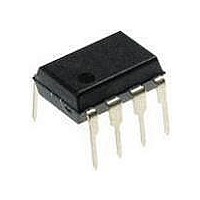PIC12F1840-I/P Microchip Technology, PIC12F1840-I/P Datasheet - Page 180

PIC12F1840-I/P
Manufacturer Part Number
PIC12F1840-I/P
Description
7 KB Flash, 256 Bytes RAM, 32 MHz Int. Osc, 6 I/0, Enhanced Mid Range Core 8 PDI
Manufacturer
Microchip Technology
Datasheet
1.PIC12F1840-IP.pdf
(382 pages)
Specifications of PIC12F1840-I/P
Processor Series
PIC12F
Core
PIC
Program Memory Type
Flash
Program Memory Size
7 KB
Data Ram Size
256 B
Interface Type
MI2C, SPI, EUSART
Number Of Timers
3
Operating Supply Voltage
1.8 V to 5.5 V
Maximum Operating Temperature
+ 85 C
Mounting Style
Through Hole
Package / Case
PDIP-8
Development Tools By Supplier
MPLAB IDE Software
Minimum Operating Temperature
- 40 C
Lead Free Status / Rohs Status
Lead free / RoHS Compliant
Available stocks
Company
Part Number
Manufacturer
Quantity
Price
Company:
Part Number:
PIC12F1840-I/P
Manufacturer:
MICROCHIP
Quantity:
200
- Current page: 180 of 382
- Download datasheet (4Mb)
PIC12(L)F1840
23.1
The DSM module can be enabled by setting the MDEN
bit in the MDCON register. Clearing the MDEN bit in the
MDCON register, disables the DSM module by auto-
matically switching the carrier high and carrier low sig-
nals to the V
source is also switched to the MDBIT in the MDCON
register. This not only assures that the DSM module is
inactive, but that it is also consuming the least amount
of current.
The values used to select the carrier high, carrier low,
and modulator sources held by the Modulation Source,
Modulation High Carrier, and Modulation Low Carrier
control registers are not affected when the MDEN bit is
cleared and the DSM module is disabled. The values
inside these registers remain unchanged while the
DSM is inactive. The sources for the carrier high, car-
rier low and modulator signals will once again be
selected when the MDEN bit is set and the DSM
module is again enabled and active.
The modulated output signal can be disabled without
shutting down the DSM module. The DSM module will
remain active and continue to mix signals, but the out-
put value will not be sent to the MDOUT pin. During the
time that the output is disabled, the MDOUT pin will
remain low. The modulated output can be disabled by
clearing the MDOE bit in the MDCON register.
23.2
The modulator signal can be supplied from the
following sources:
• CCP1 Signal
• MSSP1 SDO1 Signal (SPI mode only)
• Comparator C1 Signal
• EUSART TX Signal
• External Signal on MDMIN pin
• MDBIT bit in the MDCON register
The modulator signal is selected by configuring the
MDMS <3:0> bits in the MDSRC register.
DS41441B-page 180
DSM Operation
Modulator Signal Sources
SS
signal source. The modulator signal
Preliminary
23.3
The carrier high signal and carrier low signal can be
supplied from the following sources:
• CCP1 Signal
• Reference Clock Module Signal
• External Signal on MDCIN1 pin
• External Signal on MDCIN2 pin
• V
The carrier high signal is selected by configuring the
MDCH <3:0> bits in the MDCARH register. The carrier
low signal is selected by configuring the MDCL <3:0>
bits in the MDCARL register.
23.4
During the time when the DSM switches between car-
rier high and carrier low signal sources, the carrier data
in the modulated output signal can become truncated.
To prevent this, the carrier signal can be synchronized
to the modulator signal. When synchronization is
enabled, the carrier pulse that is being mixed at the
time of the transition is allowed to transition low before
the DSM switches over to the next carrier source.
Synchronization is enabled separately for the carrier
high and carrier low signal sources. Synchronization for
the carrier high signal can be enabled by setting the
MDCHSYNC bit in the MDCARH register. Synchroniza-
tion for the carrier low signal can be enabled by setting
the MDCLSYNC bit in the MDCARL register.
Figure 23-1
of using various synchronization methods.
SS
Carrier Signal Sources
Carrier Synchronization
through
Figure 23-5
2011 Microchip Technology Inc.
show timing diagrams
Related parts for PIC12F1840-I/P
Image
Part Number
Description
Manufacturer
Datasheet
Request
R

Part Number:
Description:
7 KB Flash, 256 Bytes RAM, 32 MHz Int. Osc, 6 I/0, Enhanced Mid Range Core, Nano
Manufacturer:
Microchip Technology
Datasheet:

Part Number:
Description:
MCU, MPU & DSP Development Tools 8 Bit PIC Develop Microcontroller
Manufacturer:
SchmartBoard
Datasheet:

Part Number:
Description:
7 KB Flash, 256 Bytes RAM, 32 MHz Int. Osc, 6 I/0, Enhanced Mid Range Core 8 DFN
Manufacturer:
Microchip Technology

Part Number:
Description:
7 KB Flash, 256 Bytes RAM, 32 MHz Int. Osc, 6 I/0, Enhanced Mid Range Core 8 SOI
Manufacturer:
Microchip Technology

Part Number:
Description:
7 KB Flash, 256 Bytes RAM, 32 MHz Int. Osc, 6 I/0, Enhanced Mid Range Core, Nano
Manufacturer:
Microchip Technology
Datasheet:

Part Number:
Description:
7 KB Flash, 256 Bytes RAM, 32 MHz Int. Osc, 6 I/0, Enhanced Mid Range Core, Nano
Manufacturer:
Microchip Technology
Datasheet:

Part Number:
Description:
7 KB Flash, 256 Bytes RAM, 32 MHz Int. Osc, 6 I/0, Enhanced Mid Range Core, Nano
Manufacturer:
Microchip Technology
Datasheet:

Part Number:
Description:
7 KB Flash, 256 Bytes RAM, 32 MHz Int. Osc, 6 I/0, Enhanced Mid Range Core, Nano
Manufacturer:
Microchip Technology

Part Number:
Description:
7 KB Flash, 256 Bytes RAM, 32 MHz Int. Osc, 6 I/0, Enhanced Mid Range Core, Nano
Manufacturer:
Microchip Technology

Part Number:
Description:
7 KB Flash, 256 Bytes RAM, 32 MHz Int. Osc, 6 I/0, Enhanced Mid Range Core, Nano
Manufacturer:
Microchip Technology
Datasheet:

Part Number:
Description:
7 KB Flash, 256 Bytes RAM, 32 MHz Int. Osc, 6 I/0, Enhanced Mid Range Core, Nano
Manufacturer:
Microchip Technology
Datasheet:

Part Number:
Description:
Manufacturer:
Microchip Technology Inc.
Datasheet:

Part Number:
Description:
Manufacturer:
Microchip Technology Inc.
Datasheet:











